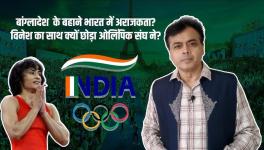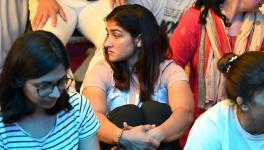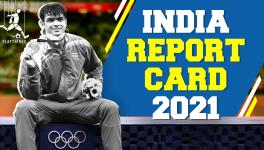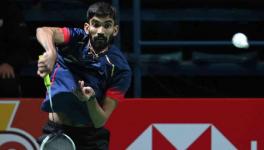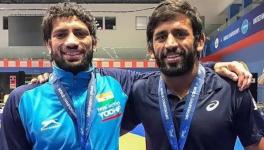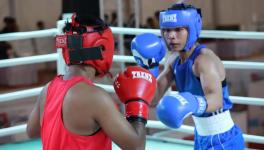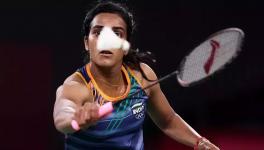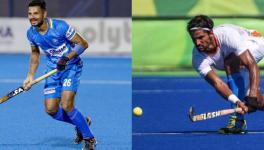When it Comes to Olympic Success, Size Rarely Matters
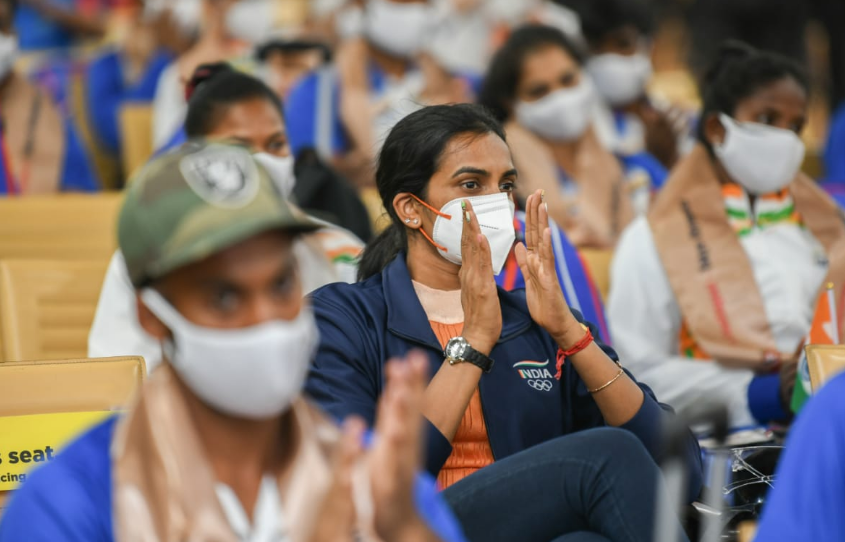
PV Sindhu at the Delhi airport during the sending off function on Saturday evening for the first batch of athletes flying to Tokyo for the Olympics (Pic: SAI Media, Twitter).
The size of a contingent matters at the Olympic Games. Or so they said to impressionable minds back in an age when international sports was consumed, almost wholly, in black and white. This was not just because we were viewing all of these on a 14-inch dichrome iteration. There was no room for gradients — from victories and losses, to heroes and villains, to numbers and last but not the least the Indian stars. Things were clearly demarcated back then, the right and wrong, the glory and ignominy, and sports did not leave us torn, or in a conscience flux like it does now, thanks to the various games that are played beyond the Games.
The year was 1988. The Olympics were being held in Seoul, not too far from Tokyo where the festival will be staged a week from now. On our small family television, the opening ceremony was being telecast. There was a crowd at home. Watching sport on television was a social affair back then much like now. But the reasons were different.
TV sets were rare, and the idea of watching the action together, talking and even having debates and fights about it, had a familial and natural feel to it. Now, social gatherings for sport are almost forced, almost an obligation induced by #FOMO more than anything else! Back then, the necessity, or the idea of it, was different. The feeling of watching sports together was different too.
Also Read | Tokyo Olympics: Past Failures at the Games Still Haunt Archer Deepika Kumari
And, in the gathering, when the USSR, USA and the Chinese teams walked into the Olympic stadium, there were murmurs of approval and admiration. The elders would speak out, “Now this is a real team of champions”. Of course, applause was reserved for the relatively smaller Indian group. We identified with the national heroes on a different level back then, impossible now despite the overwhelming advent of various social channels. This adulation was there despite the knowledge that the Olympics were not where they would create a ripple.
It did not matter though for we were still inclined to believe in participatory bliss. Victory would spoil that magic, or so it felt back then. Now the reasons for that are multi-layered and require a narration of its own. Another occasion, perhaps.
The applause was reserved for India, and admiration went to the giants. It had more to do with the sheer size of the contingents than being able to identify faces of the stars on a flickering black and white screen. They looked awe inspiring walking shoulder to shoulder in their official suits or jerseys. We could not make out the colours. But by then, having seen the El Diego World Cup on the same telly a couple of years back, we were all conditioned to understand the subtle variations in black, and white, and identify the nations, dreams and aspirations they represented.
Seoul 1988’s opening still happens to be the most colourful ceremony in my heart, simply because the colours were felt and perceived with the mind’s eye and not because a cathode ray tube was bombarding them into the retina.
And yes, the impressive size of the contingents of the top sides in the world, and their eventual positions in the medals tally that justified it and reiterated that the numbers were no pyrotechnics, strengthened the notion further. Size does matter. India went in small, came out of the Games without medals, but we celebrated the returning athletes, some of them local heroes in Kerala.
Also Read | Great Indian Hypocrisy: Calling Out Racism by English Football Fans; Ignoring the Filth at Home
The Tokyo Games is the eighth since Seoul and a parallel has surfaced, thanks to the pandemic. This edition would mostly be watched on screen, albeit 4k coloured HD ones, leaving little room for the heart to perceive things. Beyond that, much has changed, the obvious one being that the USSR is no longer present. Infact, the Russian contingent won’t walk under their national flag either owing to doping sanctions.
And, the most important change for us: India’s footprint at the Games has transformed over the course of 33 years — in size.
On Saturday night, the first batch of Indian athletes took the flight to Tokyo, 88 in all (including officials), say reports. That is almost double the total that landed in Seoul to represent the country. At the Korean capital, India had 46 athletes in the fray. This year, 127 have qualified despite the challenges thrown up by the pandemic. A new record, beating the previous mark of 117 from the Rio Games in 2016.
Size does matter, of course, but does India do justice to that statement? The answer is no. Over the course of the seven Olympics since Seoul, India have had small yet significant increments in the number of athletes making the cut. In Barcelona 1992, it was 53, in Atlanta four years later, it was 49. At the 2000 Sydney Olympics, India had 65 in the mix. The trend continued into the new century — Athens 2004 (73), Beijing 2008 (67, the men’s hockey team failed to make it), London 2012 (83), and Rio 2016 (117).
Also Read | Tokyo Olympics: IOC Issues Guidelines for Medal Ceremonies
More athletes possessing the quality to feature in the biggest sporting spectacle in the world is a good sign indeed. But, departing from the childhood notion of participatory high, as a grown up Indian with a more than average sense in matters of accountability, results have started to matter. Especially since we all know the kind of resources that are being pumped into Olympic sports in the country by the state as well as private players.
So, while celebrating the record number of boarding passes for Delhi to Tokyo in the coming week, let us also try and look at whether our record-breaking size mattered in the past Games. When we view the number of participants with the lens of results, the picture remains bleak, the returns per participant is almost the same since Atlanta 1996 when Leander Paes restarted the trend of India winning medals at the Olympics after a gap of 16 years.
From Atlanta to Athens — three Olympics — we returned with just one prize each, so the medals per participant average fell sharply since the number of athletes present at the Games were higher. Things took a change for the better at Beijing (three medals including a gold) and remarkably so at London (our best performance at the Games so far with six medals).
Post London, we were all inclined to believe the Indian Olympic juggernaut had started to roll and from then on, it would just be new highs in each edition. But then, except for the record participants, we returned with just two medals in Rio, and the statistics correlating medal count with the number of participants, showed a sharp decline.
The reason for this decline — from Beijing and London to Rio — has a lot to do with how a generation of athletes who represented India at these first two Games were nurtured in a different system, one that was primed to get India a good showing at home during the 2010 Commonwealth Games in New Delhi. From around 2006, to the CWG, a huge amount of resources and money were pumped in to prepare the athletes — for a change with accountability and systematic planning — and the results were clear then, clearer now. That period of six years or so happens to be the best ever in Indian Olympic history.
Also Read | Tokyo Olympics: List of Indians Who Made the Cut for the Games
That is past though, almost ancient history in modern sport’s timeline. Post that, everything has reset to the way things were. And we are back to chasing appearance records.
Indians, a little over 200 of them including officials who will be in Tokyo, will walk around carrying the additional burden of banishing underachievement since it has caught up with the country again, and caught up fast.
This understanding, based on cold and truthful numbers, is glossed over though, under the unjustifiable celebration of the size of the contingent flying to Japan. The union sports minister sent off the first batch at the airport, the ceremony attended by many high officials of the Indian Olympic Association (IOA). A ceremony celebrating a record that is not just meaningless but defies many cognitive processes.
This happens to be a smokescreen. Similar to how it was when we were celebrating last minute qualifiers. Those Indians who made it late for Tokyo in the fag end of June may have already peaked and may not have anything left in the tank to perform better at the Games. It was, however, celebrated as an achievement. The celebration of the size of the contingent seems to convey a similar false sense of gain, but with larger implications.
We are meant to celebrate size for sure, but to celebrate size after the numbers justify itself with a much more improved showing, and thereby enhanced stature among nations. India finished 67th in Rio, tied with Mongolia. And India had entered that Games with the largest ever contingent till date. Mongolia had 43 participants. By math and logic, it is not even a tie. Mongolia are way ahead of India.
We are doing this primary school math not to highlight past blots and discourage athletes who have undoubtedly worked hard to reach here. It is to hold the current keepers and managers of the system — the government, its bureaucracy and the sports stakeholders of the country — accountable. Not allow them to get away with failures by highlighting matters of little or no significance. It is pertinent that we dig up the stink from five years back, buried deep in PR and Khelo India fireworks, so that we realise what’s worth and what’s not, and to also understand where we are headed… the future.
Where we are at present will obviously be highlighted in a fortnight or so. Let the Games begin!
Get the latest reports & analysis with people's perspective on Protests, movements & deep analytical videos, discussions of the current affairs in your Telegram app. Subscribe to NewsClick's Telegram channel & get Real-Time updates on stories, as they get published on our website.









